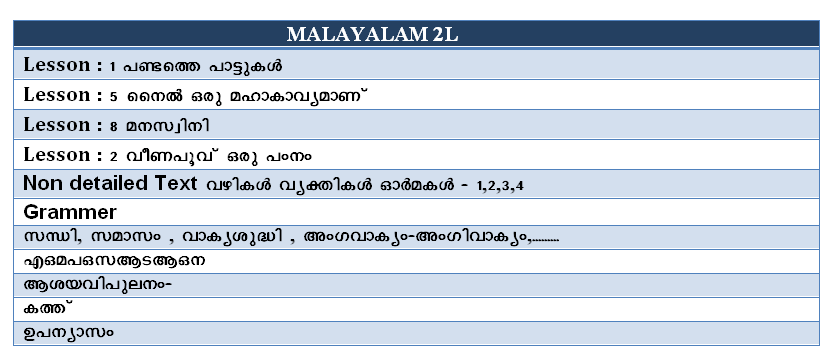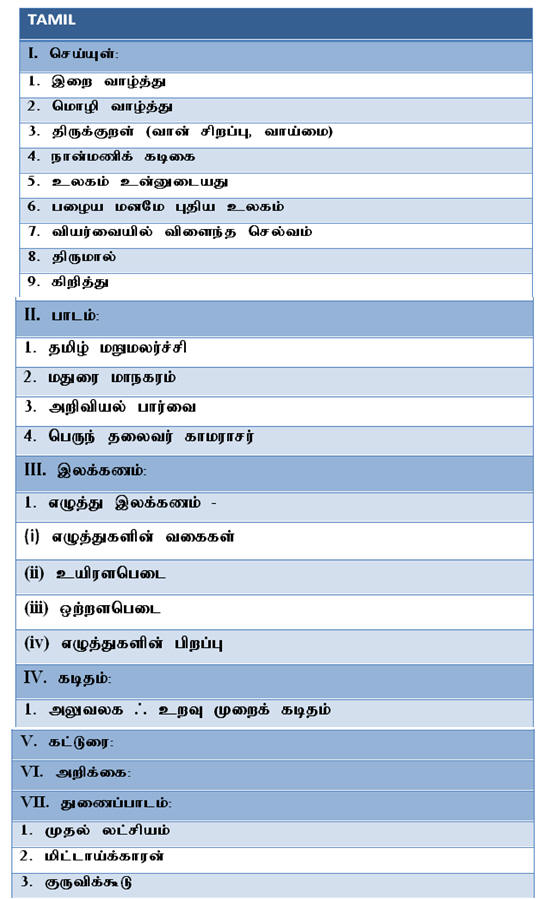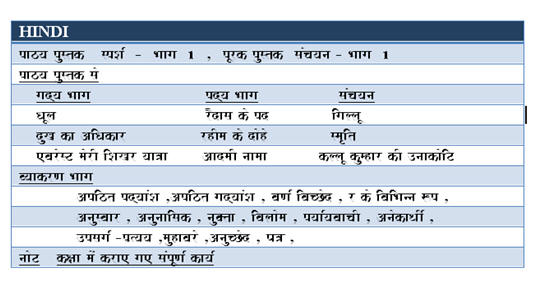|
ENGLISH |
|
MCB : Units 1-3 |
|
Writing - Short Compositions (Process Description, Dialogue Completion, Bio-Sketch, Data Interpretation) |
|
Long Compositions – Letters, Articles, Speeches, Declamation, Story- Writing (Visual or Verbal Stimulus) |
|
Literature : Prose - How I Taught My Grandmother to Read, A Dog Named Duke |
|
Poetry - The Road Not Taken, The Brook, Lord Ullin’s Daughter , The Solitary Reaper |
|
Drama – Villa For Sale |
|
|
|
Grammar : Integrated questions- (Editing, Omissions, Gap filling, Syntax, |
|
Dialogue completion, Reported speech, Passive Voice) |
|
Marking Scheme: |
|
Section A Reading - 20 marks |
|
Section B Writing - 20 marks |
|
Section C Grammar - 20 marks |
|
Section D Literature - 20 marks |
|
MATHEMATICS |
|
Chapter-1
:Number Systems |
|
SCIENCE |
|
Chapter 1.
Matter in our surroundings. |
|
Chapter
6 Tissue |
|
PRACTICALS FOR MCQ |
|
1. To test
(a) the presence of starch in the given food sample (b) the
presence of the |
|
2. To prepare |
|
a) a true solution of common salt, sugar and alum |
|
b) a suspension of soil, chalk powder and fine sand in water |
|
c) a
colloidal of starch in water and egg albumin in water and
distinguish between |
|
3. To prepare |
|
a) a mixture |
|
b) a compound |
|
using iron filings and sulphur powder and distinguish between these on the basis of: |
|
i. appearance i.e., homogeneity and heterogeneity |
|
ii. behaviour towards a magnet |
|
iii. behaviour towards carbon disulphide as a solvent. |
|
iv. effect of heat. |
|
4. To carry out the following reactions and classify them as physical or chemical changes. |
|
a. Iron with copper sulphate solution in water. |
|
b. Burning of magnesium in air. |
|
c. Zinc with dilute sulphuric acid |
|
d. Heating of copper sulphate |
|
e. Sodium sulphate with barium chloride in the form of their solutions in water |
|
5. To
prepare stained temporary mounts of (a) onion peel and (b)
human cheek cells and to |
|
6. To
identify parenchyma, collenchyma and sclerenchyma tissues in
plants, striped muscle |
|
7. To
separate the components of a mixture of sand, common salt
and ammonium chloride (or |
|
8. To determine the melting point of ice and the boiling point of water. |
|
SOCIAL SCIENCE |
|
History (18 marks) |
|
|
|
Civics- (18 marks) |
|
|
|
Economics (18 marks) |
|
|
|
FRENCH |
|
Section- A-Reading Comprehension |
|
Section –B (Writing Skills) |
|
Une lettre. |
|
Compose un dialogue d'environ 40 mots sur un de ces sujets. |
|
Racontez une histoire en utilisant les éléments donnes |
|
SECTION -C |
|
Complétez avec les pronoms personnels : |
|
Choisissez entre passe compose ou l’imparfait : |
|
Reliez les phrases en utilisant les pronoms relatifs |
|
Répondez aux questions avec la négation: |
|
Trouvez la phrase: |
|
Trouvez la question/ Répondez en utilisant les expressions négatives |
|
Complétez avec lequel. Laquelle, lesquels, lesquelles |
|
Mettez les verbes aux temps convenables |
|
Complétez avec qui, que, ou, dont |
|
Corrigez les fautes |
|
Section -D(Culture & Civilisation- (1to 7) |
|
Répondez aux questions suivantes: |
|
Faites correspondre chacune des formules a une situation |


